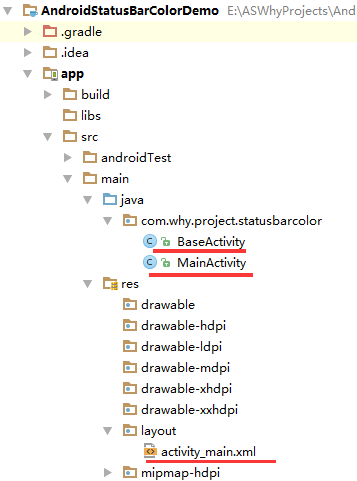Android状态栏着色
版权声明:本文为HaiyuKing原创文章,转载请注明出处!
前言
状态栏着色,也就是我们经常听到的沉浸式状态栏,关于沉浸式的称呼网上也有很多吐槽的,这里就不做过多讨论了,以下我们统称状态栏着色,这样我觉得更加容易理解。
从Android4.4开始,才可以实现状态栏着色,并且从5.0开始系统更加完善了这一功能,可直接在主题中设置<item name="colorPrimaryDark">@color/colorPrimaryDark</item>或者getWindow().setStatusBarColor(color)来实现,但毕竟4.4+的机器还有很大的占比,所以就有必要寻求其它的解决方案。
一般通过Android Studio新建项目时就实现了状态栏着色功能,不过只能在API>19的机型上正常显示。下面是通过Android studio新建项目时的默认样式代码:
styles.xml

colors.xml

AndroidManifest.xml

而本文想要实现的效果是在API>19和API<19的机型上都兼容状态栏着色效果。
效果图
| API>19 | API =19 | API <19 |

|

|

|
代码分析
- 首先将手机手机状态栏透明化
在values、values-v19、values-v21目录下分别创建相应的主题,然后在AndroidManifest.xml中给Application设置该主题。


- 在布局文件中添加
android:fitsSystemWindows="true"属性
我们使用android:fitsSystemWindows="true"属性,不让布局延伸到状态栏,这时状态栏就是透明的,然后添加一个和状态栏高、宽相同的指定颜色View来覆盖被透明化的状态栏。
- 创建View并添加到状态栏
使用步骤
一、项目组织结构图


注意事项:
- 导入类文件后需要change包名以及重新import R文件路径
- values目录下的文件(strings.xml、dimens.xml、colors.xml等),如果项目中存在,则复制里面的内容,不要整个覆盖
二、使用方法
修改valus目录下的styles.xml文件【在eclipse开发环境和Android studio开发环境中建议使用不同的样式】
- <resources>
- <!--
- Base application theme, dependent on API level. This theme is replaced
- by AppBaseTheme from res/values-vXX/styles.xml on newer devices.
- -->
- <!--
- Theme customizations available in newer API levels can go in
- res/values-vXX/styles.xml, while customizations related to
- backward-compatibility can go here.
- -->
- <!-- Eclipse开发环境 -->
- <!--<style name="AppBaseTheme" parent="android:Theme.Light.NoTitleBar">
- </style>-->
- <!-- Android Studio开发环境 -->
- <style name="AppBaseTheme" parent="Theme.AppCompat.Light.NoActionBar">
- </style>
- <!-- Application theme. -->
- <style name="AppTheme" parent="AppBaseTheme">
- <!-- All customizations that are NOT specific to a particular API-level can go here. -->
- </style>
- <!-- Android 状态栏着色 -->
- <style name="TranslucentTheme" parent="AppTheme">
- </style>
- </resources>
添加\修改values-v19目录下的styles.xml文件【在eclipse开发环境和Android studio开发环境中建议使用不同的样式】
- <resources>
- <!--
- Base application theme for API 19+. This theme completely replaces
- AppBaseTheme from BOTH res/values/styles.xml and
- res/values-v11/styles.xml on API 19+ devices.
- -->
- <!-- API 19 theme customizations can go here. -->
- <!-- Eclipse开发环境 -->
- <!--<style name="AppBaseTheme" parent="android:Theme.Light.NoTitleBar">
- </style>-->
- <!-- Android Studio开发环境 -->
- <style name="AppBaseTheme" parent="Theme.AppCompat.Light.NoActionBar">
- </style>
- <!-- Android 状态栏着色 -->
- <style name="TranslucentTheme" parent="AppTheme">
- <item name="android:windowTranslucentStatus">true</item>
- <item name="android:windowTranslucentNavigation">false</item>
- </style>
- </resources>
添加\修改values-v21目录下的styles.xml文件【在eclipse开发环境和Android studio开发环境中建议使用不同的样式】
- <resources>
- <!--
- Base application theme for API 21+. This theme completely replaces
- AppBaseTheme from BOTH res/values/styles.xml and
- res/values-v11/styles.xml on API 21+ devices.
- -->
- <!-- API 21 theme customizations can go here. -->
- <!-- Eclipse开发环境 -->
- <!--<style name="AppBaseTheme" parent="android:Theme.Light.NoTitleBar">
- </style>-->
- <!-- Android Studio开发环境 -->
- <style name="AppBaseTheme" parent="Theme.AppCompat.Light.NoActionBar">
- </style>
- <!-- Android 状态栏着色 -->
- <style name="TranslucentTheme" parent="AppTheme">
- <item name="android:windowTranslucentStatus">true</item>
- <item name="android:windowTranslucentNavigation">false</item>
- <item name="android:statusBarColor">@android:color/transparent</item>
- </style>
- </resources>
在values目录下的colors.xml文件中添加状态栏着色的颜色值代码
- <?xml version="1.0" encoding="utf-8"?>
- <resources>
- <!-- Android 状态栏着色 -->
- <color name="colorPrimary">#0164C5</color>
- </resources>
在AndroidManifest.xml中给Application设置TranslucentTheme主题
- <?xml version="1.0" encoding="utf-8"?>
- <manifest xmlns:android="http://schemas.android.com/apk/res/android"
- package="com.why.project.statusbarcolor">
- <application
- android:allowBackup="true"
- android:icon="@mipmap/ic_launcher"
- android:label="@string/app_name"
- android:supportsRtl="true"
- android:theme="@style/TranslucentTheme">
- <activity android:name=".MainActivity">
- <intent-filter>
- <action android:name="android.intent.action.MAIN"/>
- <category android:name="android.intent.category.LAUNCHER"/>
- </intent-filter>
- </activity>
- </application>
- </manifest>
在activity布局文件中的根节点元素中添加android:fitsSystemWindows="true"
- <?xml version="1.0" encoding="utf-8"?>
- <!-- Android 状态栏着色:android:fitsSystemWindows="true" -->
- <RelativeLayout
- xmlns:android="http://schemas.android.com/apk/res/android"
- xmlns:tools="http://schemas.android.com/tools"
- android:id="@+id/activity_main"
- android:layout_width="match_parent"
- android:layout_height="match_parent"
- tools:context="com.why.project.statusbarcolor.MainActivity"
- android:fitsSystemWindows="true">
- <TextView
- android:layout_width="match_parent"
- android:layout_height="56dp"
- android:text="Hello World!"
- android:textColor="#ffffff"
- android:background="@color/colorPrimary"
- android:gravity="center"/>
- </RelativeLayout>
在Activity基类以及子类中添加以下标记的代码
- package com.why.project.statusbarcolor;
- import android.content.Context;
- import android.os.Build;
- import android.os.Bundle;
- import android.support.annotation.Nullable;
- import android.support.v4.content.ContextCompat;
- import android.support.v7.app.AppCompatActivity;
- import android.view.View;
- import android.view.ViewGroup;
- import android.widget.LinearLayout;
- /**
- * Created by HaiyuKing
- * Used activity基类
- */
- public class BaseActivity extends AppCompatActivity{
- @Override
- protected void onCreate(@Nullable Bundle savedInstanceState) {
- super.onCreate(savedInstanceState);
- }
- /*==========Android 状态栏着色=============*/
- public void addStatusBarView() {
- int height;
- height = getStatusBarHeight(this);
- if (height <= 0) {
- return;
- }
- View view = new View(this);
- view.setBackgroundColor(ContextCompat.getColor(this,R.color.colorPrimary));
- LinearLayout.LayoutParams params = new LinearLayout.LayoutParams(ViewGroup.LayoutParams.MATCH_PARENT, height);
- ViewGroup decorView = (ViewGroup) findViewById(android.R.id.content);
- decorView.addView(view, params);
- }
- /**
- * 获取状态栏的高度
- * 19API以上 读取到状态栏高度才有意义
- */
- public int getStatusBarHeight(Context context) {
- if (Build.VERSION.SDK_INT >= Build.VERSION_CODES.KITKAT) {
- int resourceId = context.getResources().getIdentifier("status_bar_height", "dimen", "android");
- return resourceId > 0 ? context.getResources().getDimensionPixelSize(resourceId) : 0;
- } else {
- return 0;
- }
- }
- }
- package com.why.project.statusbarcolor;
- import android.os.Bundle;
- public class MainActivity extends BaseActivity {
- @Override
- protected void onCreate(Bundle savedInstanceState) {
- super.onCreate(savedInstanceState);
- setContentView(R.layout.activity_main);
- /*==========Android 状态栏着色=============*/
- addStatusBarView();
- }
- }
注意:
- Android studio新建的项目默认extends AppCompatActivity !如果是Eclipse开发环境则需要修改为extends Activity或者FragemntActivity或者自定义的activity基类。
- 如果activity布局中含有fragment布局,那么在Activity含有以上代码的基础上只需要在fragment布局文件中添加上android:fitsSystemWindows="true"即可
混淆配置
无
参考资料
项目demo下载地址
https://github.com/haiyuKing/AndroidStatusBarColorDemo
Android状态栏着色的更多相关文章
- Android 透明状态栏&着色状态栏
Android 5.0 及以上实现方式(android在5.0之后引入Material Design 实现方式相对简单) 透明状态栏,背景浸入状态栏 if (Build.VERSION.SDK_INT ...
- Android开发-状态栏着色原理和API版本号兼容处理
介绍 先上实际效果图,有三个版本号请注意区分API版本号 API>=20 API=19 API<19 watermark/2/text/aHR0cDovL2Jsb2cuY3Nkbi5uZX ...
- Android状态栏颜色修改
android状态栏颜色修改 状态栏颜色的修改在4.4和5.x环境下分别有不同的方式,低于4.4以下是不能修改的. 5.x环境下 方式一,状态栏将显示为纯净的颜色,没有渐变效果 /** * 状 ...
- Android状态栏透明(沉浸式效果)
Android状态栏透明(沉浸式效果) 默认效果 沉浸式效果 方式一 源码 下载地址(Android Studio工程):http://download.csdn.net/detail/q487880 ...
- Android如何着色字符串的特定部分
文章选自StackOverflow(简称:SOF)精选问答汇总系列文章之一,本系列文章将为读者分享国外最优质的精彩问与答,供读者学习和了解国外最新技术.本文探讨Android如何着色字符串的特定部分. ...
- android状态栏和NavigationBar的动态控制显示
项目在开发阅读器,阅读器对阅读界面的要求就是在工具栏不显示的状态下,ActionBar和NavigationBar都是不显示的,当工具栏显示时它们都出来,这就需要动态控制它们的显示与隐藏. 第一阶段: ...
- [Android] 状态栏的一些认识
前段时间遇到几个关于状态栏的问题,又了解了一下状态栏相关的知识,现在做一下记录. 本文地址:http://www.cnblogs.com/rossoneri/p/4316343.html 前戏和问题 ...
- android状态栏总结
针对状态栏的操作,只针对4.4kitKat(含)以上的机型,部分国产rom会失效,目前发现的有华为的EMUI Activity必须是noActionbar主题 本文基于StatusBarUtils略作 ...
- Translucent Bar Android状态栏自定义颜色
Android4.4 一个很重要的改变就是透明系统栏..新的系统栏是渐变透明的, 可以最大限度的允许屏幕显示更多内容, 也可以让系统栏和 Action Bar 融为一体, 仅仅留下最低限度的背景保护以 ...
随机推荐
- UnicodeEncodeError: 'ascii' codec can't encode character...的解决方法
在python2.7下,因为想从数据库中读出来分类名进行写入到文件,提示 Traceback (most recent call last): File "test.py", li ...
- 关于Kafka配额的讨论(2)
继续前一篇的讨论.前文中提到了两大类配额管理:基于带宽的以及基于CPU线程使用时间的.本文着重探讨基于CPU线程时间的配额管理. 定义 这类配额管理被称为请求配额(request quota),管理起 ...
- 用beego开发服务端应用
用beego开发服务端应用 说明 Quick Start 安装 创建应用 编译运行 打包发布 代码生成 开发文档 目录结构说明 使用配置文件 beego默认参数 路由设置 路由的表述方式 直接设置路由 ...
- Elasticsearch笔记三之版本控制和插件
版本控制 1:关系型数据库使用的是悲观锁,数据被读取后就被锁定其他的线程就无法对其进行修改. 2:ex使用的是乐观锁,数据被读取后其他程序还可以对其进行修改,而执行修改时发现此数据已经被修改则修改就会 ...
- 【Homework】LCA&RMQ
我校是神校,作业竟然选自POJ,难道不知道“珍爱生命 勿刷POJ”么? 所有注明模板题的我都十分傲娇地没有打,于是只打了6道题(其实模板题以前应该打过一部分但懒得找)(不过感觉我模板还是不够溜要找个时 ...
- h5仿微信聊天(高仿版)、微信聊天表情|对话框|编辑器
之前做过一版h5微信聊天移动端,这段时间闲来无事就整理了下之前项目,又重新在原先的那版基础上升级了下,如是就有了现在的h5仿微信聊天高仿版,新增了微聊.通讯录.探索.我四个模块 左右触摸滑屏切换,聊天 ...
- 大白话5分钟带你走进人工智能-第十四节过拟合解决手段L1和L2正则
第十四节过拟合解决手段L1和L2正则 第十三节中, ...
- Vue之生命周期函数和钩子函数详解
在学习vue几天后,感觉现在还停留在初级阶段,虽然知道怎么和后端做数据交互,但是对对vue的生命周期不甚了解.只知道简单的使用,而不知道为什么,这对后面的踩坑是相当不利的.因为我们有时候会在几个钩子函 ...
- Python爬虫入门教程 56-100 python爬虫高级技术之验证码篇2-开放平台OCR技术
今日的验证码之旅 今天你要学习的验证码采用通过第三方AI平台开放的OCR接口实现,OCR文字识别技术目前已经比较成熟了,而且第三方比较多,今天采用的是百度的. 注册百度AI平台 官方网址:http:/ ...
- 【干货分享】可能是东半球最全的.NET Core跨平台微服务学习资源
如果你发现还有西半球的资源,烦请相告,不胜感谢! 一..NET Core基础 微软英文官网 .NET Core 微软中文官网 GitHub 用ASP.NET内核和Azure构建现代Web应用程序 博客 ...
